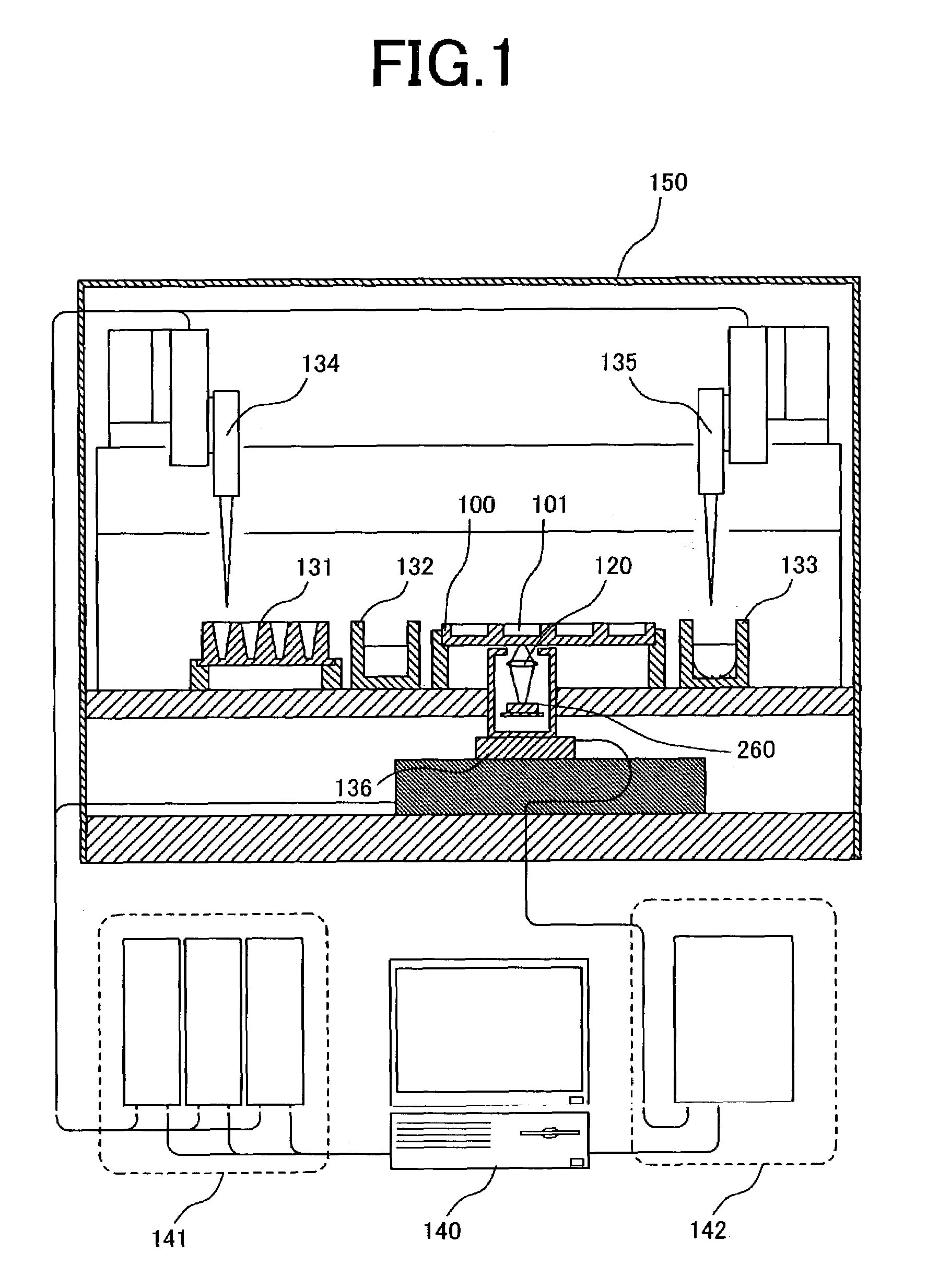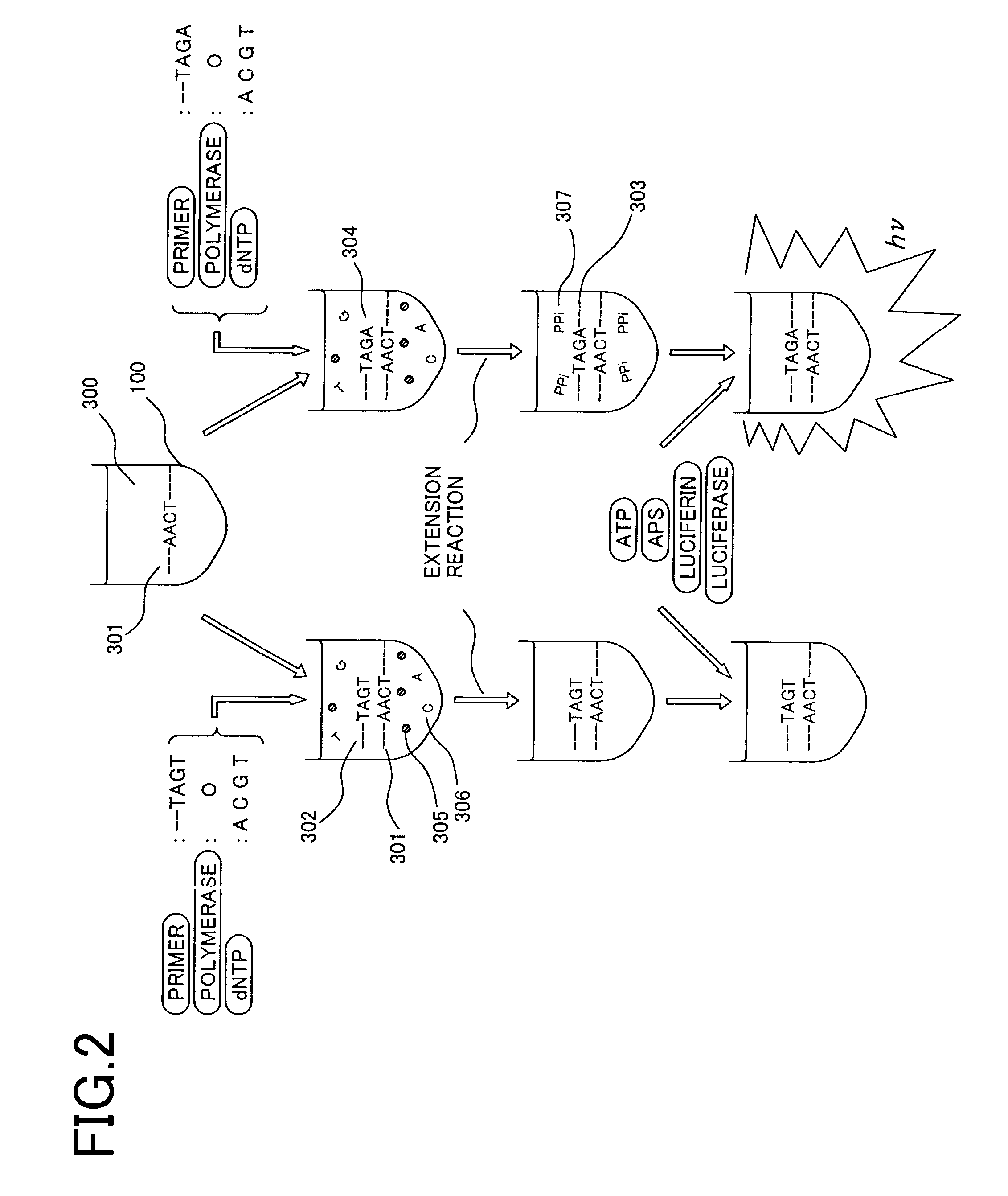Apparatus and method for luminometric assay
a luminometric assay and apparatus technology, applied in the field of apparatus and system for dna detection, can solve the problems of difficult significant obstacle in the optical system relating to the excitation light source, and achieve the effect of significantly simplifying the optical system, reducing the cost of miniaturization and cost reduction, and strengthening the optical coupling between a sample and an optical sensor
- Summary
- Abstract
- Description
- Claims
- Application Information
AI Technical Summary
Benefits of technology
Problems solved by technology
Method used
Image
Examples
example 1
[0044]FIG. 3A is a cross-sectional view of a sample plate and optical sensor array illustrating an example of the present invention. A plurality of reaction baths and pixels are brought into a one-to-one correspondence and disposed in close proximity to each other. Here, a sample plate 100 comprises a plurality of reaction baths (2 mm in diameter, 2 mm in depth) 101a–c on a glass substrate. The bottom surface of the reaction baths is transparent, and a part of the light emitted from a sample arrives at an optical sensor array disposed underneath the sample plate. An optical sensor array 200 is composed of photodiodes 210a–c formed on a silicon substrate. Here, the positional relationship between the photodiodes and reaction baths is important. In conventional DNA assay apparatus, determination by fluorescence labelling is mainly utilized, and thus excitation light is required. Since the fluorescence, which is the signal, is faint in comparison with the intensity of the excitation li...
example 2
[0048]FIG. 3B shows a block diagram of an optical sensor array comprising 2 pixel-addressing circuits. FIGS. 7A to 7C show the circuitry diagram of the optical sensor array. Taking a photosensitive part 202 and a mechanism for resetting the photosensitive part and forwarding signals as 1 unit 210 (hereafter, referred to as “pixel”), a plurality of pixels is arranged on the same silicon substrate. The array shown in FIG. 3B comprises 36 pixels, wherein each pixel comprises a photodiode 202, a metal oxide semiconductor (hereafter, referred to as “MOS”) transistor for reset 211, an MOS transistor for readout 212, and MOS transistors for pixel selection 213 and 214. Each pixel is independently selected by means of a decoder for target pixel selection (S-decoder) 204 or a decoder for control pixel selection (C-decoder) 205, and a signal is output to output terminals 207 and 208 corresponding to the respective decoders.
[0049]Conventionally, a shift register has been mainly used as a means...
example 3
[0053]FIG. 11A shows an example of the configuration of a part in which a signal is output by way of output lines 220 and 221 corresponding to the decoder for selection of a target pixel (S-decoder) 204 and the decoder for selection of a control pixel. Current sources 412 and 413 are connected to output line for a target pixel signal 220 and output line for a control pixel signal 221, respectively, and, for example, current is initially set to 2 mA. The two output lines are connected to an input terminal of a differential amplifier 401, the output of the differential amplifier is connected to a sample / hold circuit, and the output thereof is read into a control computer 404 via an AD converter 403. Prior to measuring luminescence from a target sample, a target-sample and control-sample are measured at the same time in a state where the target-sample is not allowed to emit luminescence, for example in a state where luciferin, the luminescence substrate, is not added thereto, and the s...
PUM
| Property | Measurement | Unit |
|---|---|---|
| distance | aaaaa | aaaaa |
| diameter | aaaaa | aaaaa |
| resistivity | aaaaa | aaaaa |
Abstract
Description
Claims
Application Information
 Login to View More
Login to View More - R&D
- Intellectual Property
- Life Sciences
- Materials
- Tech Scout
- Unparalleled Data Quality
- Higher Quality Content
- 60% Fewer Hallucinations
Browse by: Latest US Patents, China's latest patents, Technical Efficacy Thesaurus, Application Domain, Technology Topic, Popular Technical Reports.
© 2025 PatSnap. All rights reserved.Legal|Privacy policy|Modern Slavery Act Transparency Statement|Sitemap|About US| Contact US: help@patsnap.com



